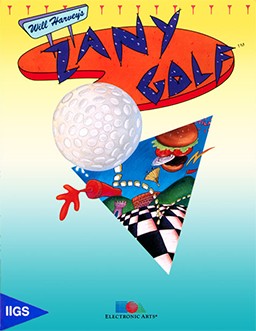
Zany Golf, also known as Will Harvey's Zany Golf, is a fantasy take on miniature golf developed by Sandcastle Productions and published by Electronic Arts in 1988. The game was originally written for the Apple IIGS and subsequently ported to the Amiga, Atari ST, and MS-DOS compatible operating systems. In 1990, a port was released for the Sega Genesis. The game was developed by Will Harvey, Ian Gooding, Jim Nitchals, and Douglas Fulton. Harvey was pursuing his advanced degrees at Stanford University at the time.

Mercenary is a 3D action-adventure game written for the Atari 8-bit family and published by Novagen Software in 1985. It was converted to the Commodore 64, ZX Spectrum, Amstrad CPC, Atari ST, Amiga and Commodore 16/116/Plus/4 platforms. The game uses vector graphics renderings of vast, sparse environments and has open-ended gameplay. It was also released as Mercenary: Escape from Targ and Mercenary: A Flight Simulator Adventure.
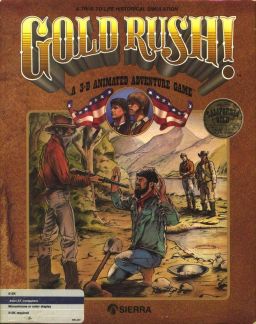
Gold Rush! is a graphic adventure video game designed by Doug and Ken MacNeill and originally released by Sierra On-Line in 1988.

Fiendish Freddy's Big Top o' Fun is a video game developed by Gray Matter under developer Chris Gray and published in 1990 by Mindscape. It originally appeared on the 16-bit Atari ST, IBM PC and Commodore Amiga, before later being converted to the ZX Spectrum, Commodore 64, Amstrad CPC. The Commodore 64 version was included on cartridge bundled with the Commodore 64 Games System.

Time Bandit is a maze shoot 'em up written for the TRS-80 Model I by Bill Dunlevy and Harry Lafnear and published by MichTron in 1983. It was ported to the TRS-80 Color Computer and Dragon 32, but enjoyed its greatest popularity several years later as an early release for the Atari ST. It was also released for the pseudo-PC-compatible Sanyo MBC-55x with 8-color display. Amiga and MS-DOS versions were ported by Timothy Purves.

Sleeping Gods Lie was a first-person adventure game released on the Amiga, DOS and Atari ST, published by Empire Interactive in 1989.

The Immortal is an isometric action-adventure game originally created by Will Harvey and released by Electronic Arts in 1990 for the Apple IIGS. It was soon ported to the Amiga, Atari ST, DOS, Nintendo Entertainment System, and Genesis. A wizard is attempting to find his mentor in a large and dangerous labyrinth. It has a high degree of graphic violence. In 2020, the NES port was re-released on the Nintendo Switch Online service, while the Genesis port was re-released on the Piko Collection Collection 1 cartridge for the Evercade.
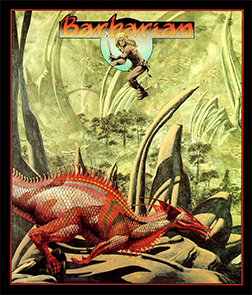
Barbarian is a 1987 platform game by Psygnosis. It was first developed for the Atari ST, and was ported to the Amiga, Commodore 64, MS-DOS, MSX, Amstrad CPC, and ZX Spectrum. The Amiga port was released in 1987; the others were released in 1988. The cover artwork is by fantasy artist Roger Dean.

Basil the Great Mouse Detective is a platform, action-adventure game designed by Bob Armour and published by Gremlin Graphics in 1987 for the Amstrad CPC, Atari 8-bit and Commodore 64 home computers. The game is based on the 1986 Disney animated film The Great Mouse Detective.

World Tour Golf is a 1986 video game by Evan and Nicky Robinson, Paul Reiche III and published by Electronic Arts for Commodore 64, Amiga, Apple IIGS, and DOS.

Mines of Titan is a single-player role-playing video game, developed by Westwood Associates, and released by Infocom in 1989 for Apple II, Commodore 64 and MS-DOS.
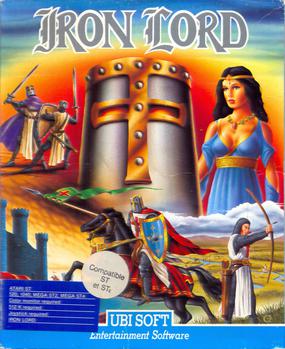
Iron Lord is an adventure video game developed by Orou Mama and Ivan Jacot for the Atari ST and published by Ubi Soft in 1989. It was ported to the Amiga, Acorn Archimedes, Amstrad CPC, Commodore 64, ZX Spectrum, and DOS.

Escape from Singe's Castle, also known as Dragon's Lair Part II - Escape From Singe's Castle, is a computer game for the Amstrad CPC, Commodore 64 and ZX Spectrum home computers, released by Software Projects in 1987.

Dream Zone is an adventure game developed by JAM Software and published by Baudville. It was released in 1988 for the Apple IIGS and then ported to MS-DOS, Amiga, and Atari ST.
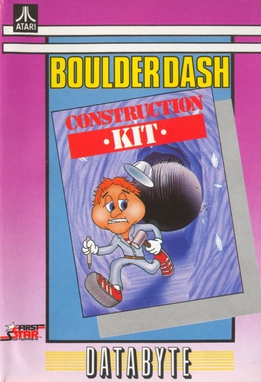
Boulder Dash Construction Kit is the fourth game in the Boulder Dash series. It published for the Commodore 64 and Atari 8-bit family in 1986 by Epyx. Ports were released for the Apple II, Atari ST, Amiga, Amstrad CPC, ZX Spectrum, and MS-DOS. The Spectrum version was rereleased as Boulder Dash IV: The Game. Boulder Dash Construction Kit includes new levels and a level editor.

Mercenary III is the third and final video game in the Mercenary series. It was written by Paul Woakes for the Atari ST and Amiga and published by Novagen Software in 1992.

Spy vs. Spy II: The Island Caper is a 1985 video game. It is the sequel to Spy vs. Spy.

TV Sports: Football is a 1988 video game by Cinemaware for Amiga, Atari ST, Commodore 64, DOS, and TurboGrafx-16.
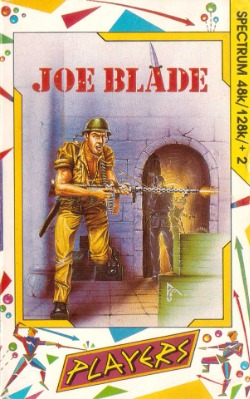
Joe Blade is the first game in the Joe Blade series. It reached the top of the UK game charts, replacing Renegade. In Germany, the game peaked at number 7.
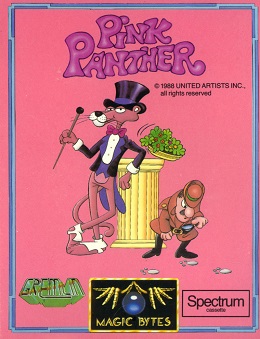
Pink Panther is a 1988 video game based on the character of the same name. It was developed by German company Magic Bytes and published by Gremlin Graphics. It was released in Europe for Amiga, Amstrad CPC, Atari ST, Commodore 64, and ZX Spectrum. Pink Panther was criticized for its control and difficulty, although the Amiga and Atari ST versions received praise for their graphics.





















